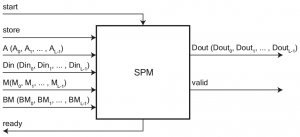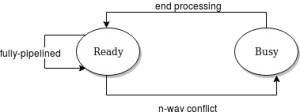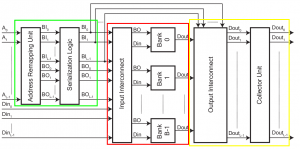Scratchpad unit
Like existing GPU-like core projects, nu+ provides limited hardware support for shared scratchpad memory. The nu+ core presents a configurable GPU-like oriented scratchpad memory (SPM) with built-in support for bank remapping. Typically, scratchpad memories are organized in multiple independently-accessible memory banks. Therefore if all memory accesses request data mapped to different banks, they can be handled in parallel (at best, with L memory banks, L different gather/scatter fulfilled in one clock cycle). Bank conflicts occur whenever multiple requests are made for data within the same bank. If N parallel memory accesses request the same bank, the hardware serializes the memory accesses, causing an N-way conflict and an N-times slowdown. The nu+ SPM dynamic bank remapping mechanism, based on specific kernel access pattern, minimizes bank conflicts.
Contents
Interface and operation
Interface
As shown in the figure above, the I/O interface of the SPM has several control and data signals. Due to the scattered memory access of the processor, all the data signals, both in input and in output, are vectors and every index identifies a corresponding lane of the core unit. So, SPM has the following data inputs for each lane:
A: address of the memory location to be accessed;Din: word containing data to be written (in the case of scatter operation);BM[0..W-1]: W-bit-long bitmask to enable/disable the writing of each byte ofDinword;M: bit asserted if the lane will participate in the next instruction execution.
As for inputs, the SPM has a single data output for each lane that is:
Dout: data stored at the addresses contained inA.
The store signal is an input control signal. If store is high, the requested instruction will be a scatter operation, otherwise it is a gather one. The value of store signal is the same for all the lanes. Due to the variability of latency it is necessary to introduce some control signals that allow to implement a handshaking protocol between the control logic of the SIMD core (owner of the CUDA Thread Block) and the SPM control logic. These signals are:
startis an input signal and is asserted by the core control unit to request the execution of an instruction;readyis an output signal and is asserted by the SPM when it can process a new instruction;validis an output signal and is asserted by the SPM when the execution of an instruction is finished and its outputs are the final outcome.
FSM model
As said, the SPM takes as input L different addresses to provide support to the scattered memory access (and its multi-banking implementation). It can be regarded as a finite state machine with the following two states:
- Ready
- - the SPM is ready to accept a new memory request.
- Busy
- - the SPM cannot accept any request as it is still processing the previous one.
In the Ready state the ready signal is high and there are no issuing requests. In the Busy state all input requests will be ignored. Assuming the loaded instruction relates to conflicting addresses, the SPM goes into the Busy state and sets the ready signal as low. At the end of the memory access serialization, the SPM passes into the Ready state. If the SPM is involved in the execution of another instruction, the ready signal is low and the input instruction is not yet accepted. If an instruction is free of conflicts, the SPM executes it without passing in the Busy state. So consecutive instructions without conflicts can be executed without interruptions, just as if the SPM were a fully pipelined execution unit.
Customizable features
The SPM is totally configurable. In particular it is possible to customize the number of lanes of the SIMD core unit (L), the number of memory banks (B), the number of entries contained in a bank (D) and the number of bytes that make up an entry in a memory bank (W) simply by changing the value of the respective parameters in the SPM configuration file.
`define SM_PROCESSING_ELEMENTS 16 //L `define SM_ENTRIES 1024 //D `define SM_MEMORY_BANKS 16 //B `define SM_BYTE_PER_ENTRY 4 //W `define SM_ENTRY_ADDRESS_LEN $clog2(`SM_ENTRIES) //entry address lenght `define SM_MEMORY_BANK_ADDRESS_LEN $clog2(`SM_MEMORY_BANKS) //memory bank address lenght `define SM_BYTE_ADDRESS_LEN $clog2(`SM_BYTE_PER_ENTRY) //byte address lenght `define SM_ADDRESS_LEN `SM_ENTRY_ADDRESS_LEN + `SM_MEMORY_BANK_ADDRESS_LEN + `SM_BYTE_ADDRESS_LEN //address length
Architecture
Overview
The memory is byte addressable and each word is four byte wide. Ricordarsi di introdurre is misaligned da scratchpad_memory_pipe.sv.
Stage 1
The first stage (in thegreenbox in the figure above) has the task of carrying out conflict detection and serialization of conflicting memory requests. If the SPM is in the Ready state, it will carry out the incoming requests. If a conflict is detected while the SPM is in the Ready state, the SPM moves to the Busy state and serializes conflicting requests. If the SPM is in the Busy state, it will not accept inputs until the last serialized requests is served.
Address Remapping Unit
The Address Remapping Unit computes in parallel the bank index and the bank offset for each of the L memory addresses coming from the processor lanes. Bank index (BI[0..L-1] in figure above) is the index of the bank to which the address is mapped. Bank offset (BO[0..L-1] in figure above) is the displacement of the word into the bank. Furthermore, the Address Remapping Unit behavior can be changed at runtime in order to change the relationship between addresses and banks, allowing the adoption of the mapping strategy that best suits the executed workload. The Address Decode Unit is the component dedicated to actually performing the decoding process of the mapping strategy. The cyclic-mapping strategy is the only currently supported and is very easy to implement: it assigns the first word to the first memory bank, the second word to the second memory bank and so on, repeating the assignment process every B times (where B is the number of memory banks) and considering bank indexes 0 and B-1 as consecutive.
Serialization Logic Unit
The Serialization Logic Unit performs the conflict detection and the serialization of the conflicting requests. Whenever an n-way conflict is detected, the Serialization Logic Unit puts the SPM in the busy state and splits the requests into n conflict-free requests issued serially in the next n clock cycles. When the last request is issued, the Serialization Logic Unit put the SPM in the ready state. Notice that for the Serialization Logic Unit, multiple accesses to the same address are not seen as a conflict, as in this occurrence a broadcast mechanism is activated. This broadcast mechanism provides an efficient way to satisfy multiple load requests for the same constant parameters.
Stage 2
Il secondo stadio è quello che ospita i banchi di SRAM. Tale presenta l'interconnessione di ingresso, la quale inoltra le richieste provenienti delle lane all'opportuno banco di memoria in funzione dell'indirizzo.
Input Interconnect
The Input Interconnect is an interconnection network that steers source data and/or control signals coming from a lane in the GPU-like processor to the destination bank. Because the Input Interconnect follows the Serialization Logic Unit, it only accepts one request per bank.
Banked memory
Then, there are the B memory banks providing the required memory elements. Each memory bank receives the bank offset, the source data, and the control signal form the lane that addressed it. Each bank has a single read/write port with a byte-level write enable signal to support instructions with operand sizes smaller than word. Furthermore, each lane controls a bit in an L-bit mask bus that is propagated through the Input Interconnect to the appropriate bank. This bit acts as a bank enable signal. In this way, we can disable some lanes and execute operations on a vector smaller than L elements.
Stage 3
Il terzo stadio presenta l'interconnesssione d'uscita la quale ha il compito di redirigere i dati provenienti dai banchi di memoria verso la lane di destinazione. Inoltre possiede dei registri d'uscita i quali collezionano tutte le risposte. Il segnale sm3_is_last_request viene asserito quando tutte le letture serializzate provenienti da una stessa richiesta sono state collezionate e quindi sono presenti in uscita.
Output Interconnect
The Output Interconnect propagates the loaded data to the lane that requested it.
Collector Unit
Last, there is a Collector Unit which is a set of L registers that collect the results coming from the serialized requests outputting them as a single vector.
5/5/2019
INTERFACCIA E FUNZIONALITA' ingressi parametrizzabili
MODULI Stadio 0 (overview)
4/5/2019
INTERFACCIA E FUNZIONALITA' FSM (differenza comportamento fully-pipelined e n-way conflicts)
2/5/2019
INTERFACCIA E FUNZIONALITA' Vista modulare con ingressi-uscite (con descrizione)
24/4/2019
INTERFACCIA E FUNZIONALITA'
Vista modulare con ingressi-uscite (con descrizione) FSM (differenza comportamento fully-pipelined e n-way conflicts) ingressi parametrizzabili
MODULI
Stadio 0 (pipe) Stadio 1 (stage1) Stadio 2 (stage2) Stadio 3 (stage3)
ESEMPIO DI FUNZIONAMENTO
Si deve aggiungere l'attributo __scratchpad per avere la sicurezza che una variabile venga allocata in SPM. Definire qualche esempio più specifico (e.g. conv_layer_mvect_mt con uno o due core)


